Tuol Sleng Genocide Museum
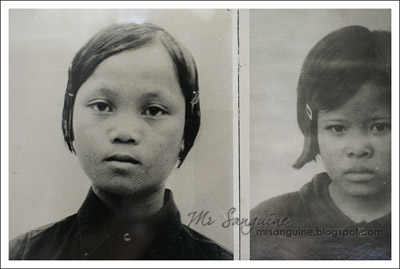
The Khmer Rouge came into power in 1975 and brought with them a regime of terror, mindless executions and starvation in Cambodia. The Tuol Sleng Genocide Museum serves as a stark reminder to those dark days of modern Cambodian history.
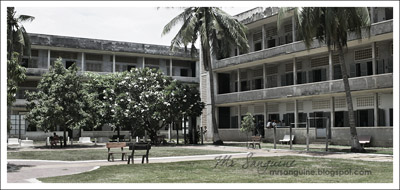
Originally run as a high school called Ponhea Yat when it opened in 1962, the building was converted by the Khmer Rogue into a detention center in 1975. It was renamed Tuol Sleng which roughly translates to "mound of poisonous trees" in the Khmer language. The buildings were also collectively known as S-21 or Security Office 21. The compound consists of 5 main buildings used to house prison cells, torture rooms, administrative offices and living quarters. The graves of several dead prisoners found by the Vietnamese army when Tuol Sleng was liberated are sited in the far left corner of the image above. The Khmer Rogue executed all surviving prisoners as the Vietnamese approached Phnom Penh.
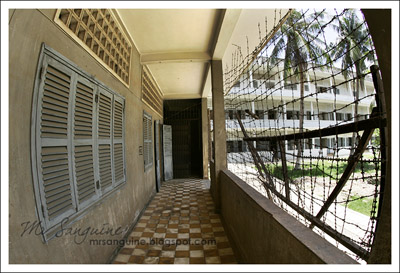
Rough estimates show about 17,000 political prisoners were interned and executed in Tuol Sleng from 1975 to 1979. A small number in comparison to the estimated 2 million who lost their lives during the short reign of the Khmer Rouge but it is often remembered for the level of brutality committed in such a concentrated space. Killing prisoners was actually discouraged in Tuol Sleng but many inevitably died from the torture and disease which was rampant in the prison. Confessions were usually exacted from prisoners under torture and they were thereafter carted off to the nearby Choeung Ek killing fields for final disposal.
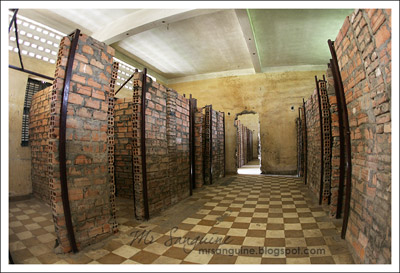
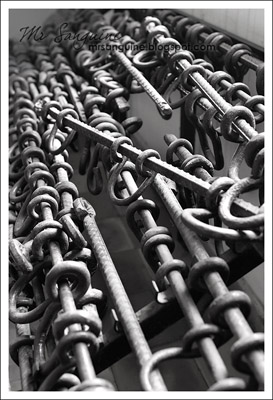
Prisoners were kept in holding cells which came in a variety of sizes. Single occupants were often shackled to the cell walls and in the larger lockups, prisoners had their legs shackled together via a long steel rod pictured above. A shorter rod about 1 meter in length was used for 3 to 4 prisoners while the longer 6 meter rods were designed to hold up to 30 prisoners. The prisoners were secured to the rods on alternating sides and had to sleep with their heads in opposing directions. This example shows how these restraints were used, the picture contains a rather graphic scene. And a painting depicting the arrangement of prisoners within the holding rooms.
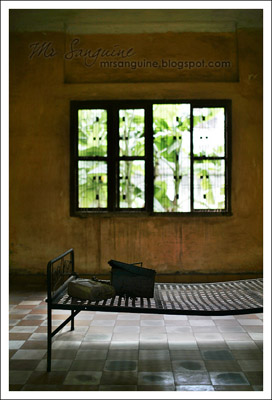

Prisoners from all walks of life were subjected to systematic torture within the confines of Tuol Sleng. Many were educated people, politicians, teachers, artists... men and women, young and old, none were spared. Out of the thousands which came in, there are only 7 known survivors. Prisoners were strapped onto bare metal beds and suffered many different forms of torture including beatings, electric shocks and strangulation. Many prison guards were children ranging from 10 to 15 years of age. Most started out timid but grew to enjoy the torture they exacted on the prisoners. Vann Nath was a survivor of Tuol Sleng, saved by his skills as a painter, he was tasked with recording the activities in Tuol Sleng through his paintings. His canvas showed many horrific scenes, prisoner torture, rampant infanticide, and killings. Up till recently, pools of dried blood could still be seen in the torture rooms but this has since been removed.
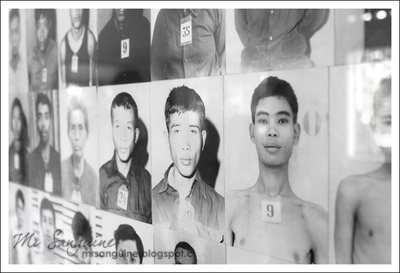
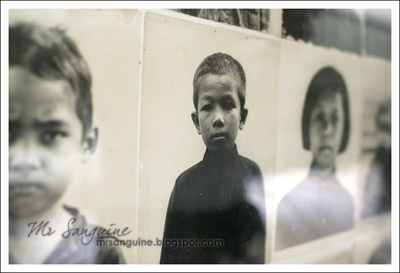
Immaculate records were kept of each prisoner from the time of entry till execution. Each one was photographed and detailed biographies of their lives recorded from their childhood years. These photographs are now on display, many of the mug shots show prisoners with bewildered and startled expressions. There were many infants amongst those photographed.
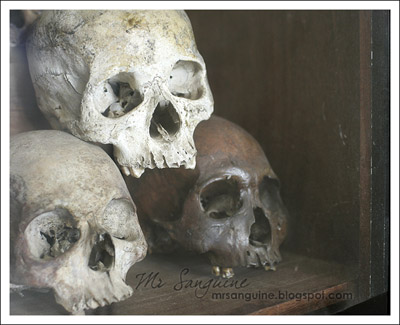
Up until 2002, a map of Cambodia shaped out of 300 skulls from prisoners of Tuol Sleng was displayed. Since then, the decision was made to dismantle the map and the skulls respectfully displayed in glass cabinets. This action was supported by many human rights groups as well as the Cambodian government.
My 2 hour visit to Tuol Sleng left me with a deep sense of sorrow. Even after 30 years, the horror of what took place there was still very much apparent. The buildings are left virtually unchanged from the days of the Khmer Rouge, apart from a few modifications to accomodate the exhibition displays. Buddhist monks were conducting rites in the gardens while I was there and this is apparently a common occurence as many locals still believe restless souls roam the halls and corridors of S-21. Do include a visit to Tuol Sleng if you're ever in Phnom Penh, if only to remind ourselves how far the human race has come since then and how much farther we have to go in a world where genocide is still commonplace .




i am deeply distraught after reading ur writing... btw I'm a foreign student, studying in Singapore Bible College now.
thanks for sharing, very good photography, and insightful information...
Posted by Anonymous |
September 01, 2006 1:24 PM
Anonymous |
September 01, 2006 1:24 PM
really great photog! it was indeed a tragedy..
Posted by huey |
September 02, 2006 2:20 AM
huey |
September 02, 2006 2:20 AM
Some very moving and emotionally charged shots there man.
To move someones emotion with a photograph is truly a trstament to your shots.
Im humbled,
Peace
Jay
Posted by Jay Gannon |
September 02, 2006 4:46 PM
Jay Gannon |
September 02, 2006 4:46 PM
very spontaneous conceptualised photography.
Fantastic work.
your logo should be less obstrusive and take a smaller space.
It'll make your photos look more professional(at least the ones here)and less like from gettyimages.com
burningcellluloid-.blogspot
Posted by Wallace |
October 28, 2006 12:33 AM
Wallace |
October 28, 2006 12:33 AM
webleedwood - the watermark is used to protect my copyright to an extent and it was intentionally placed to be slightly obstrusive. I've had too many of my non watermarked works leeched by magazines and other publications in the past.
Posted by Mr Sanguine |
October 28, 2006 9:02 AM
Mr Sanguine |
October 28, 2006 9:02 AM